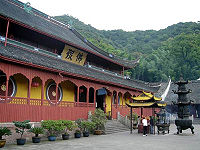Views
Tiāntóng sì 天童寺
|
|
|
|
Tiāntóng sì 天童寺 is one of the most important Chán 禪 training monasteries in China.
Contents |
History
It is said that in the Western Jìn 西晉 in the first year year of Yǒngkāng 永康 (300 C.E.), a monk named Yìxīng 義興 was traveling around China. He stopped at the future location of Tiāntóng Temple to chant sūtras. His chanting caused the Grand Imperial Jade Thearch 玉皇大帝 to send Venus (Tàibái 太白) down to serve him in the form of a Celestial Lad (Tiāntóng 天童). This is the origin of the name of both the temple and the hill upon which it sits, and when a temple was built here in 757 (Zhìdé 至德 2), it was given the name of the "Temple of the Celestial Lad" (Tiāntóng sì 天童寺).
This temple has long been an important center for Chán 禪 practice, both in China and for monks from abroad. The founders of the two main Zen sects in Japan both received dharma transmission here. Yōsai/Eisai 榮西 (founder of the Japanese Rinzai Sect 臨濟宗) studied here in 1168 (Gāndào 乾道 4), and Dōgen 道元 (founder of the Japanese Sōtō Sect 曹洞宗) studied here in 1223 (Jiādìng 嘉定 14).
Reflecting its continued importance for Chán practice, in 1392 (Hóngwǔ 洪武 25) during the Míng 明 Dynasty, the name of the temple was officially lengthened to Tiāntóng chán sì 天童禪寺. By the end of the Míng, the temple was comprised of nearly a thousand buildings covering nearly 600,000 square meters of land.
Around [[1901, Jìchán 寄禪 became abbot. He went on to do much to revive Chán practice during the last decade of the Qīng 清 Dynasty. Also in 1901, Dàojiē 道階 lectured here on the Chéng wéishì lùn 成唯識論, Lotus Sūtra 法華經, and Léngyán (Śūraṃgama) Sūtra 楞嚴經.
Yīngcí 應慈 was ordained here in the first three years of the 20th century. Ordinations were held here in 1904, notable ordinands included Tàixū 太虛.
Personnel
Important Abbots
Notable Residents
Temple Institution
Important Buildings or Artifacts
Associated Organizations and Groups
Notes
References
- Luó Zhéwén 羅哲文, et. al. Zhōngguó zhùmíng fójiào sìmiào 中國著名佛教寺廟 (Famous Buddhist Temples of China). Beijing: Zhongguo chengshi, 1995. Pp. 175-177.
- Sū Zhèshēng 蘇浙生. Shénzhōu fójìng 神州佛鏡 (Buddhist Regions of Shénzhōu). Shanghai: Shanghai guji, 2003. Pp. 180-182.
- 天童寺續志 (1920/Mínguó 民國 9)), from Dharma Drum's Temple Gazetteer Project.
- Entry for 天童寺 from Chinese Wikipedia.
- Entry for 天童寺 from the Digital Dictionary of Buddhism.
